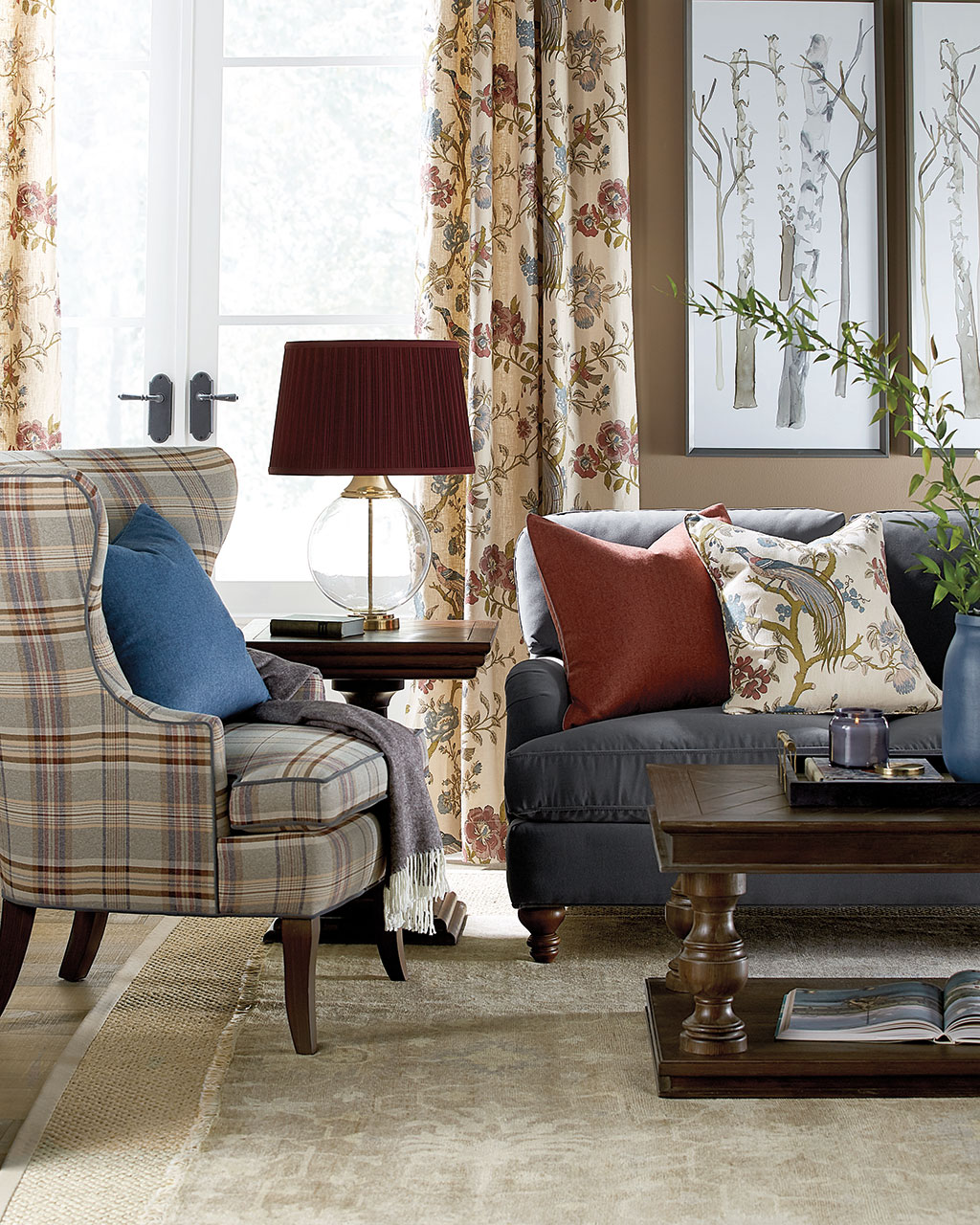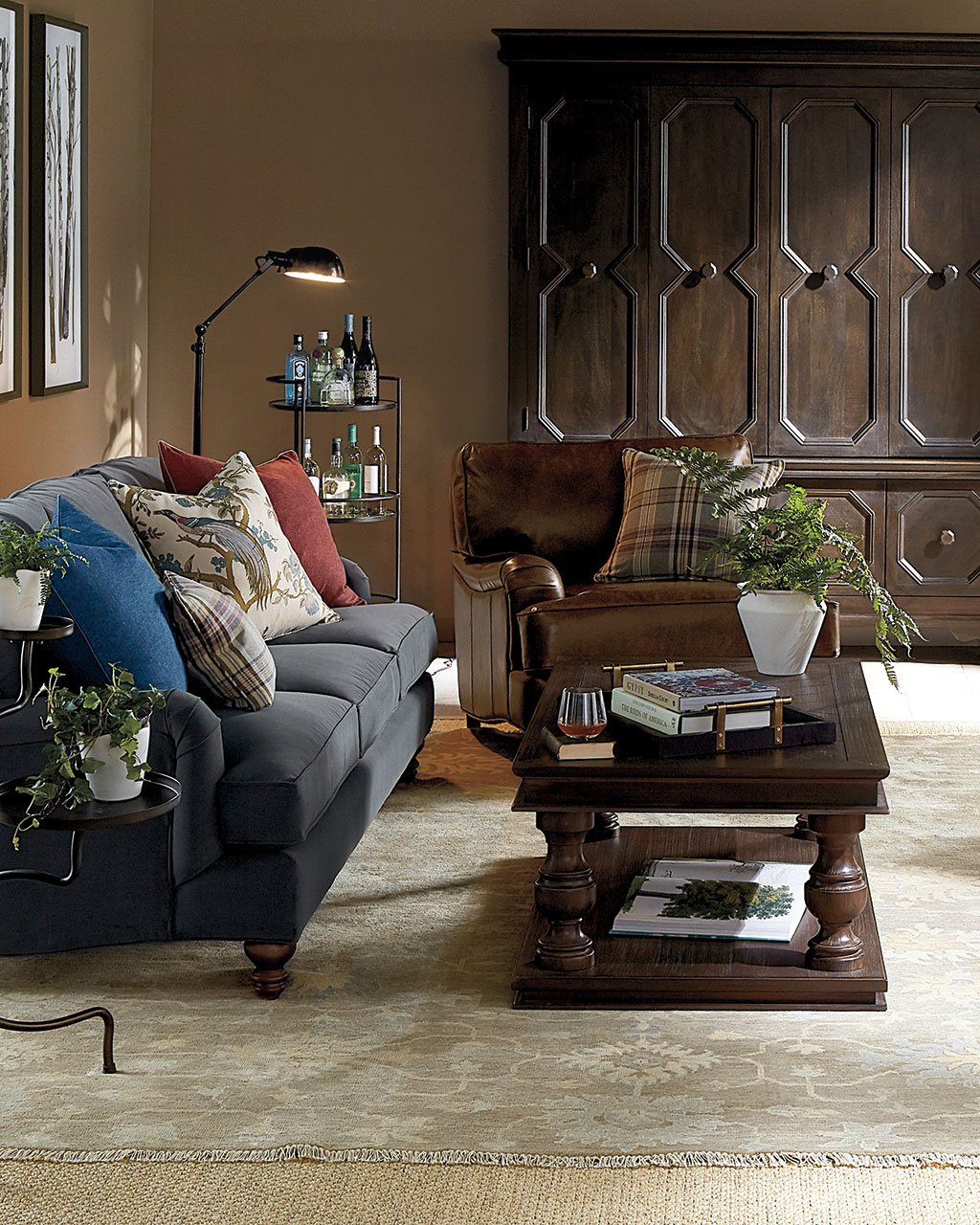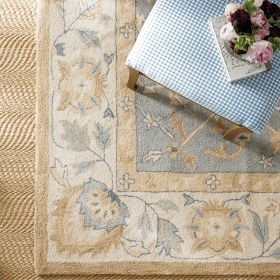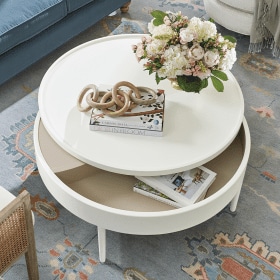 Often we hear from designers that they like to begin the entire design of a client’s space with the living room rug. Because the rug covers such a large amount of space in the finished room, it needs to work seamlessly with fabrics, colors, and most importantly the function of your space.
Often we hear from designers that they like to begin the entire design of a client’s space with the living room rug. Because the rug covers such a large amount of space in the finished room, it needs to work seamlessly with fabrics, colors, and most importantly the function of your space.
In this post, we’ll share the best ways to choose a living room rug, how to design your entire space around a rug you already have, and important things to consider when rug shopping.
1. Starting With the Rug Pattern
Let your living room rug kick off the design of the entire room. Whether you have an existing rug or you’ve fallen in love with something, starting from the ground up can ensure you have a successful finished room.
Advantages of Pattern
There are lots of reasons to use a patterned rug in your space. Most importantly, patterns are a great way to combat stains, spills, and wear and tear. Often a great pattern can combat pet hair too. Second, pattern rugs often have lots of colors in them, so you can take your room’s color palette in a number of directions.
 Here’s something important to consider about rug patterns: they always look quieter once they’re flat on the floor. Studies have shown that because rugs aren’t at eye level, the patterns themselves appear quieter and more muted. So you can choose a bolder, more vibrant rug for your space than you might otherwise be comfortable with.
Here’s something important to consider about rug patterns: they always look quieter once they’re flat on the floor. Studies have shown that because rugs aren’t at eye level, the patterns themselves appear quieter and more muted. So you can choose a bolder, more vibrant rug for your space than you might otherwise be comfortable with.
Rug Color Palettes
Let’s talk about the color palette of your favorite patterned rug. Take the Mazinda Rug above. It has so many colors – ochre, yellow, green, teal, coral – and we built the whole living room around that color palette. The sofa got a warm neutral, similar to the background of the rug, and we added the same teal blue and rich mustard yellows from the rug in the fabrics of pillows and accent chairs.

Rugs with lots of subtle colors in them are a great long term investment, because you can emphasize different colors in the rug as your tastes change. Maybe in a few years, you want to pull more green or coral from the rug and deemphasize the blue. With a patterned rug, you can do that.
2. Function
Of course, before you go rug shopping it’s important to consider the function of your room. This will help narrow down your choices when shopping and guide you in what materials and rug construction you’ll need.
Materials
The material of your favorite rug will impact its durability, cleaniblility, and softness. Pay attention to a rug’s materials to make sure you choose the right option for your room. Here are the most commonly used materials and the advantages of each.

- Wool – Wool rugs are often considered the gold standard. They’re durable, soft to the touch, hold their pile, and are easy to clean. As a natural material, stains are easy to remove from wool rugs with soap and water. It’s also a renewable, all-natural option.
- Natural Fibers – Jute, seagrass, and sisal are the most common natural materials used in rugs. They’re strong, natural grass fibers that are woven together in a variety of ways. Natural fiber rugs are typically very durable, ideal for high traffic areas. The one downside, often natural fiber rugs aren’t as soft underfoot as wools, cottons, and synthetic blends.
- Natural Fiber Blends – Technology has a come a long way, and it’s common now to see other materials mixed into natural fiber rugs to make them softer underfoot. Look for natural fibers mixed with wool, cotton, viscose, or polyester for a softer natural fiber option.
- Cotton – Cotton is often used for flat-weave rugs like dhurries or kilims. While they’re typically more afforable and very soft, they aren’t as durable as wool.
- Synthetic – Viscose, polyester, and nylon are commonly found in rug blends to increase durability and softness. They have many of the same advantages of a wool rug – softness, easy to clean, durable – but at a lower price point. It’s common to see any of these fibers used to blend with natural fiber or wool rugs.
- Polypropylene – This synthetic material is almost exclusively used for outdoor rugs. They’re easy to clean, bleach-able, won’t fade in the sun, and won’t mildew or mold. Use a polypropylene rug as a door mat or in areas that are exposed to water.
Construction
The construction of a rug will impact the rug pile, or the density and thickness of the fibers. A short rug pile feels nearly flat, while a longer pile (think shag rule) will be long.

- Hand-Knotted – Like wool rugs, a hand-knotted rug is considered the gold standard. Each piece of yarn is literally tied by hand in a knot, often taking months to create a single rug. Hand-knotted rugs incredibly durable, can last 100s of years, and are considered heirlooms.
- Hand-Hooked – Hooked rugs are constructed by pushing yarn through a pre-made mesh foundation from back to front and front to back. This creates a thick, looped pile.
- Hand Tufted – Similar to a hooked method, a tufted rug is made using the same back to front and front to back process, except the loops are trimmed at the end for more softness.
- Flat weave – Flat weave rugs have no pile, so they’re literally flat. They are reversible, lightweight, but do need a rug pad to stay in place. They’re easy to vacuum and don’t shed, but crumbs or materials aren’t as camouflaged as they’ll sit right on top of the fibers.
Sizing Your Living Room Rug
While we dive more deeply into choosing the correct rug size in this article, it’s important to address how a rug size can effect the overall finished product.
As a general rule, we recommend choosing the largest rug size your room can fit, leaving 4-10 inches are the edge of the rug for exposing your floor.

In this article, we talk about how a rug that’s too small is one of the most common decorating mistakes, and we can’t stress that enough. It’ll make your room seem smaller and more choppy and may even result in the rug shifting in your room. Very frustrating!
Tip: Your rug should be large enough that at least two legs of each furniture piece should rest on the rug. In other words, the front two legs of your sofa and all chairs and table should be placed on the rug.
Layering Rugs
If you have a rug that is too small for the space, but you love the color or pattern, consider layering a smaller rug on top of a much larger neutral option. Here, we’ve layered a hand-knotted rug on top of a natural fiber rug. This adds color, pattern, and softness to the room, at the appropriate size
3. Coordinating with the Living Room Rug
Colors
Whether you’re starting with your favorite rug or shopping for a living room rug to coordinate with fabrics and accessories you already have, color is an easy way to unite the design of the room and ensure all of your pieces work together.

In the room above, we started with the Carli Hand Tufted Rug and choose fabrics that coordinated, like our Marletta Fabric and Suzanne Kasler’s Mandarin Linen.
Choose a simple color palette, like classic blue and white, and incorporate several shades of the same hue. In the rooms above, blue rugs reenforce echo the other fabrics and accessories and add energy to the space.
Learn More – Colorful Rooms: How to Add Color to Every Space
Pattern Mixing
Don’t be intimidated by mixing patterns, especially when working in a strong color palette. Here’s our formula: a solid, a stripe, a geometric, and a floral. Each of these patterns can work seamlessly together in the same same, especially if the color coordinates.

Another great pattern to incorporate into your space? Consider a subtle animal print, like our Antelope Rug. The subtle stripe and dot of the animal print complements lots of patterns like florals, stripes, and bold geometrics. Here we paired the warm neutral color with a floral pattern with taupes and greys. The Antelope Rug pulls out the warm sand in the background of our Becca Cloud fabric, coordinating but not matching perfectly.
Your living room rug doesn’t have to match your room’s color palette perfectly. Neutral options, like natural fiber rugs, work beautifully for high traffic areas and in spaces where you don’t want to use a lot of pattern.
4. Care & Maintenance
Once you’ve chosen your living room rug, be sure to take a few final steps to make sure the rug functions and stays put in your room. A good quality rug pad is important. It keeps your rug in place and adds extra cushion. Playrooms, kids’ rooms, and family rooms are great places to use an extra thick rug pad.
Don’t forget about carpet tape! For runners or flat weave rugs that are prone to moving around, carpet tape can keep things secure.
Once everything is in place, you’ll need to tackle some basic upkeep to make sure your new favorite rug is looking it’s best. Here are our best tips:
- Vacuum regularly
- Blot spills immediately with a wet cloth
- For stain treatment, use either mild soap or carpet cleaner. Make short circular motions with a toothbrush, then dab with clean water.
- Get rugs cleaned professionally every one or two years.
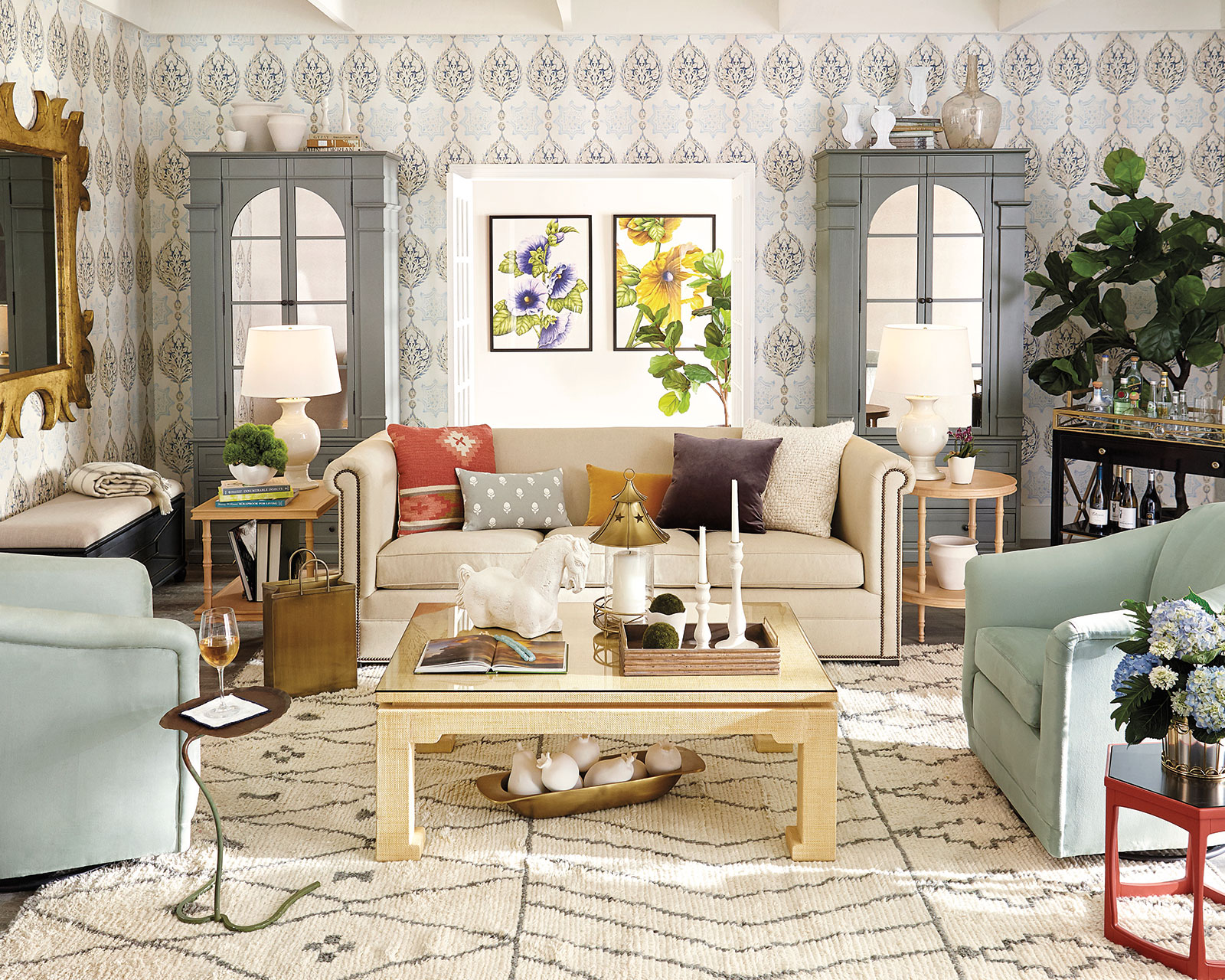 Need more help? Read these related posts to learn more:
Need more help? Read these related posts to learn more:
- Rug Buying Guide
- Choosing the Right Rug
- How to Care for Your Rug
- 5 Common Decorating Mistakes and How to Fix Them
- Living Room Lighting: How to Layer More Light Into Your Space
- 15 Best Living Room Layout Tips
To stay up to date with all things How to Decorate, sign up for our monthly newsletter.




